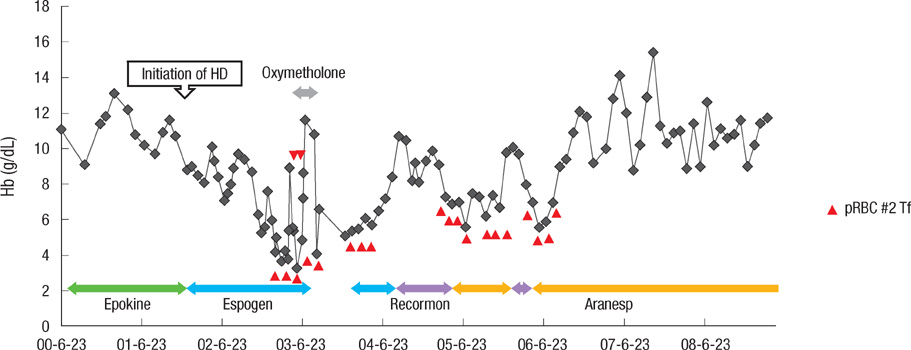J Korean Med Sci.
2010 Nov;25(11):1676-1679. 10.3346/jkms.2010.25.11.1676.
Improvement in Erythropoieis-stimulating Agent-induced Pure Red-cell Aplasia by Introduction of Darbepoetin-alpha When the Anti-erythropoietin Antibody Titer Declines Spontaneously
- Affiliations
-
- 1Divison of Nephrology, Department of Internal Medicine, Seoul National University Hospital, Seoul, Korea.
- 2Transplantation Center, Seoul National University Hospital, Seoul, Korea.
- 3Kwon's Medical Clinic, Nonsan, Korea.
- 4Kidney Research Institute, Medical Research Center, Seoul National University, Seoul, Korea.
- KMID: 1779243
- DOI: http://doi.org/10.3346/jkms.2010.25.11.1676
Abstract
- Anti-erythropoietin antibodies usually cross-react with all kinds of recombinant erythropoietins; therefore, erythropoiesis-stimulating agent (ESA)-induced pure red-cell aplasia (PRCA) is not rescued by different ESAs. Here, we present a case of ESA-induced PRCA in a 36-yr-old woman with chronic kidney disease, whose anemic condition improved following reintroduction of darbepoetin-alpha. The patient developed progressive, severe anemia after the use of erythropoietin-alpha. As the anemia did not improve after the administration of either other erythropoietin-alpha products or erythropoietin-beta, all ESAs were discontinued. Oxymetholone therapy failed to improve the transfusion-dependent anemia and a rechallenge with ESAs continuously failed to obtain a sustained response. However, her anemia improved following reintroduction of darbepoetin-alpha at 3 yr after the initial diagnosis. Interestingly, anti-erythropoietin antibodies were still detectable, although their concentration was too low for titration. In conclusion, darbepoetin-alpha can improve ESA-induced PRCA when the anti-erythropoietin antibody titer declines and its neutralizing capacity is lost.
Keyword
MeSH Terms
-
Adult
Anemia/drug therapy/etiology
Antibodies/*blood/immunology
Bone Marrow Cells/pathology
Drug Hypersensitivity/immunology
Erythropoietin/*analogs & derivatives/therapeutic use
Erythropoietin, Recombinant/adverse effects/*immunology/therapeutic use
Female
Glomerulonephritis, IGA/complications
Hematinics/adverse effects/immunology/*therapeutic use
Humans
Kidney Failure, Chronic/complications
Oxymetholone/therapeutic use
Red-Cell Aplasia, Pure/chemically induced/*drug therapy/immunology
Figure
Reference
-
1. Weber G, Gross J, Kromminga A, Loew HH, Eckardt KU. Allergic skin and systemic reactions in a patient with pure red cell aplasia and anti-erythropoietin antibodies challenged with different epoetins. J Am Soc Nephrol. 2002. 13:2381–2383.
Article2. Casadevall N, Dupuy E, Molho-Sabatier P, Tobelem G, Varet B, Mayeux P. Autoantibodies against erythropoietin in a patient with pure red-cell aplasia. N Engl J Med. 1996. 334:630–633.
Article3. Bennett CL, Cournoyer D, Carson KR, Rossert J, Luminari S, Evens AM, Locatelli F, Belknap SM, McKoy JM, Lyons EA, Kim B, Sharma R, Costello S, Toffelmire EB, Wells GA, Messner HA, Yarnold PR, Trifilio SM, Raisch DW, Kuzel TM, Nissenson A, Lim LC, Tallman MS, Casadevall N. Long-term outcome of individuals with pure red cell aplasia and antierythropoietin antibodies in patients treated with recombinant epoetin: a follow-up report from the Research on Adverse Drug Events and Reports (RADAR) Project. Blood. 2005. 106:3343–3347.
Article4. Macdougall IC, Roche A, Rossert J, Casadevall N, Francois P, Kemeny DM. Re-challenging patients who developed pure red cell aplasia with epoetin: can it be done? Nephrol Dial Transplant. 2004. 19:2901–2905.
Article5. Yang J, Joo KW, Kim YS, Ahn C, Han JS, Kim S, Lee JS. Two cases of pure red-cell aplasia due to anti-erythropoietin antibodies. J Nephrol. 2005. 18:102–105.6. Summers S, Holdsworth S, Sharples E. The (re)challenging question of erythropoiesis-stimulating agents inducing pure red cell aplasia. Nephrol Dial Transplant. 2008. 23:3053–3055.
Article7. Mandreoli M, Finelli C, Lopez A, Ascani S, Vianelli N, Baccarani M, Santoro A. Successful resumption of epoetin alfa after rituximab treatment in a patient with pure red cell aplasia. Am J Kidney Dis. 2004. 44:757–761.
Article8. Westerlund P, Kurkus J, Segelmark M. Rapid resolution of EPO-induced pure red cell aplasia after a course of immunoadsorption therapy using protein A columns. Am J Kidney Dis. 2005. 45:e97–e99.
Article9. Pollock C, Johnson DW, Horl WH, Rossert J, Casadevall N, Schellekens H, Delage R, De Francisco A, Macdougall I, Thorpe R, Toffelmire E. Pure red cell aplasia induced by erythropoiesis-stimulating agents. Clin J Am Soc Nephrol. 2008. 3:193–199.
Article10. Rossert J, Macdougall I, Casadevall N. Antibody-mediated pure red cell aplasia (PRCA) treatment and re-treatment: multiple options. Nephrol Dial Transplant. 2005. 20:Suppl 4. iv23–iv26.
Article11. Vartia A, Asola MR, Tertti R, Kunelius P, Metsarinne KP. Two haemodialysis patients with epoetin alfa-induced pure red-cell aplasia recovered despite treatment with another epoetin preparation. Nephrol Dial Transplant. 2004. 19:1313–1316.
Article12. Summers SA, Matijevic A, Almond MK. Successful re-introduction of recombinant human erythropoietin following antibody induced pure red cell aplasia. Nephrol Dial Transplant. 2004. 19:2137–2139.
Article13. Asari A, Gokal R. Pure red cell aplasia secondary to epoetin alpha responding to Darbepoetin alpha in a patient on peritoneal dialysis. J Am Soc Nephrol. 2004. 15:2204–2207.
Article14. Viron B, Dupuy CA, Kolta A, Casadevall N. Successful re-challenge with darbepoetin in a patient with rHu-EPO-induced pure red cell aplasia refractory to immunosuppressive drugs. Nephrol Dial Transplant. 2008. 23:2416–2418.
Article15. Cournoyer D, Toffelmire EB, Wells GA, Barber DL, Barrett BJ, Delage R, Forrest DL, Gagnon RF, Harvey EA, Laneuville P, Patterson BJ, Poon MC, Posen GA, Messner HA. Anti-erythropoietin antibody-mediated pure red cell aplasia after treatment with recombinant erythropoietin products: recommendations for minimization of risk. J Am Soc Nephrol. 2004. 15:2728–2734.
Article16. Woodburn KW, Fan Q, Winslow S, Chen MJ, Mortensen RB, Casadevall N, Stead RB, Schatz PJ. Hematide is immunologically distinct from erythropoietin and corrects anemia induced by antierythropoietin antibodies in a rat pure red cell aplasia model. Exp Hematol. 2007. 35:1201–1208.
Article
- Full Text Links
- Actions
-
Cited
- CITED
-
- Close
- Share
- Similar articles
-
- Successful Rechallenge with Darbepoetin Following Immunosuppressive Therapy in a Dialysis Patient with Erythropoietin-Induced Pure Red Cell Aplasia
- Successful Erythropoietin Therapy after Alemtuzumab and Cyclosporin a Treatment for Epoetin-Induced Pure Red Cell Aplasia
- Pure Red-Cell Aplasia Due to Antibodies Against Erythropoietin
- Pure Red Cell Aplasia in Pregnancy
- Erythropoietin Antibody-Positive Pure Red Cell Aplasia Diagnosed after Surgical Intervention for Malignant Gastric Ulcer Bleeding



